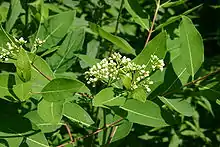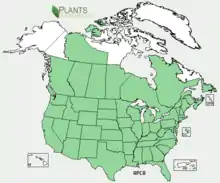Apocynum cannabinum
Apocynum cannabinum (dogbane, amy root, hemp dogbane, prairie dogbane, Indian hemp, rheumatism root, or wild cotton)[2] is a perennial herbaceous plant that grows throughout much of North America—in the southern half of Canada and throughout the United States.[1][3] It is a poisonous plant: Apocynum means "poisonous to dogs". All parts of the plant are poisonous and can cause cardiac arrest if ingested. However, some Lepidoptera feed on this plant, such as two hummingbird moths.[4] The specific epithet cannabinum and the common names hemp dogbane and Indian hemp refer to its similarity to Cannabis as a fiber plant (see hemp), rather than as a source of a psychoactive drug.
| Apocynum cannabinum | |
|---|---|
 | |
| Apocynum cannabinum in flower | |
| Scientific classification | |
| Kingdom: | Plantae |
| Clade: | Tracheophytes |
| Clade: | Angiosperms |
| Clade: | Eudicots |
| Clade: | Asterids |
| Order: | Gentianales |
| Family: | Apocynaceae |
| Genus: | Apocynum |
| Species: | A. cannabinum |
| Binomial name | |
| Apocynum cannabinum | |
 | |
| Natural range in North America | |
| Synonyms[1] | |
|
List
| |
Although dogbane is poisonous to livestock, it likely got its name from its resemblance to a European species of the same name.[5]
Description
Apocynum cannabinum grows up to 2 m (6 ft 7 in) tall. The stems are reddish and contain a milky latex capable of causing skin blisters. The leaves are opposite, simple broad lanceolate, 7–15 cm (2 3⁄4–6 in) long and 3–5 cm (1 1⁄4–2 in) broad, entire, and smooth on top with white hairs on the underside. It flowers from July to August, has large sepals, and a five-lobed white corolla. The flowers are hermaphrodite (have both male and female organs) and are pollinated by moths and butterflies.[6]
Distribution and habitat
Apocynum cannabinum grows in open wooded areas, ditches, and hillsides. It is found in gravelly or sandy soil, mainly near streams in shady or moist places.[6]
This species is native to North America. However, in gardens it can be unwanted, growing from spreading roots. When growing among corn, Apocynum cannabinum can reduce yields by up to 10% and when growing among soybeans, by up to 40%. It can be controlled through mechanical means, although it is difficult to control with herbicides.
Ecology
The plant serves as a larval host for the snowberry clearwing (Hemaris diffinis) and hummingbird clearwing (Hemaris thysbe) moths. These moths are pollinators that resemble small hummingbirds.
Uses
The plant can be used for various purposes. The most used parts are the seeds, the root, and the bark.
Fiber
Apocynum cannabinum was used as a source of fiber by Native Americans[7] to make bows, fire-bows, nets, tie down straps, hunting nets, fishing lines, and clothing.[5] It is called qéemu [qǽːmu] in Nez Perce and [taxʷɨ́s] in Sahaptin. The Concow tribe call the plant pö (Konkow language).[8]
Chewing gum
After the latex has been squeezed from the plant, it is allowed to stand overnight to harden into a white gum which can be used (sometimes mixed with clean clay) as chewing gum.[6]
Phytoremediation
Apocynum cannabinum is a phytoremediation plant, a hyperaccumulator used to sequester lead in its biomass.
Medicinal
It is also used in herbal medicine to treat fever,[9] and dysentery. Although the toxins from the plant can cause nausea and catharsis, it has also been used for slowing the pulse,[9] and it is also a sedative and mild hypnotic. It is an unpleasantly bitter stimulant irritant herb that acts on the heart, respiratory and urinary systems, and also on the uterus. Apocynum cannabinum was much employed by various Native American tribes who used it to treat a wide variety of complaints including rheumatism, coughs, pox, whooping cough, asthma, internal parasites, diarrhoea and also to increase milk flow in lactating mothers.[6] The root has been used as a tonic, cardiotonic, diaphoretic, diuretic, emetic (induces vomitting) and expectorant.[9][6] It is harvested in the autumn and dried for later use. The fresh root is the most active part medicinally.[6] A weak tea made from the dried root has been used for cardiac diseases and also as a vermifuge (an agent that expels parasitic worms).[6] The milky sap is a (presumably topically applied) folk remedy for venereal warts.[6] The plant is still used in modern herbalism, though it should be used with great caution and only under the supervision of a qualified practitioner if taken internally.
References
- "Apocynum cannabinum". World Checklist of Selected Plant Families (WCSP). Royal Botanic Gardens, Kew. Retrieved June 18, 2014 – via The Plant List.
- "Apocynum cannabinum". Integrated Taxonomic Information System.
- "Apocynum cannabinum". County-level distribution map from the North American Plant Atlas (NAPA). Biota of North America Program (BONAP). 2014.
- "Hummingbird Moth (Hemaris spp.)". Retrieved July 23, 2017.
- Heiser, C. B. (2003). Weeds in my Garden: Observations on some Misunderstood Plants. Portland, OR: Timber Press. p. 50. ISBN 0-88192-562-4.
- "Apocynum cannabinum". Plants for a Future. Retrieved Jan 4, 2015.
- Coville, F. V. (1897). "Notes On The Plants Used By The Klamath Indians Of Oregon" (PDF). Contributions from the U.S. National Herbarium. 5 (2): 87–108 (p. 103).
- Chesnut, V. K. (1902). "Plants used by the Indians of Mendocino County, California". Contributions from the U.S. National Herbarium. 7 (3): 295–408 (p. 407). LCCN 08010527.
- Felter, Harvey (1922). The Eclectic Materia Medica, Pharmacology and Therapeutics. Eclectic Medical Publications. ISBN 1888483032.
| Wikiversity has bloom time data for Apocynum cannabinum on the Bloom Clock |
- Blanchan, Neltje (2002). Wild Flowers: An Aid to Knowledge of our Wild Flowers and their Insect Visitors. Project Gutenberg Literary Archive Foundation.
- A. Davis, K. Renner, C. Sprague, L. Dyer, D. Mutch (2005). Integrated Weed Management. MSU.
External links
- Jepson Manual Treatment - Apocynum cannabinum
- University of Michigan at Dearborn, Native American Ethnobotany: Apocynum cannabinum
- Apocynum cannabinum in the CalPhotos Photo Database, University of California, Berkeley
